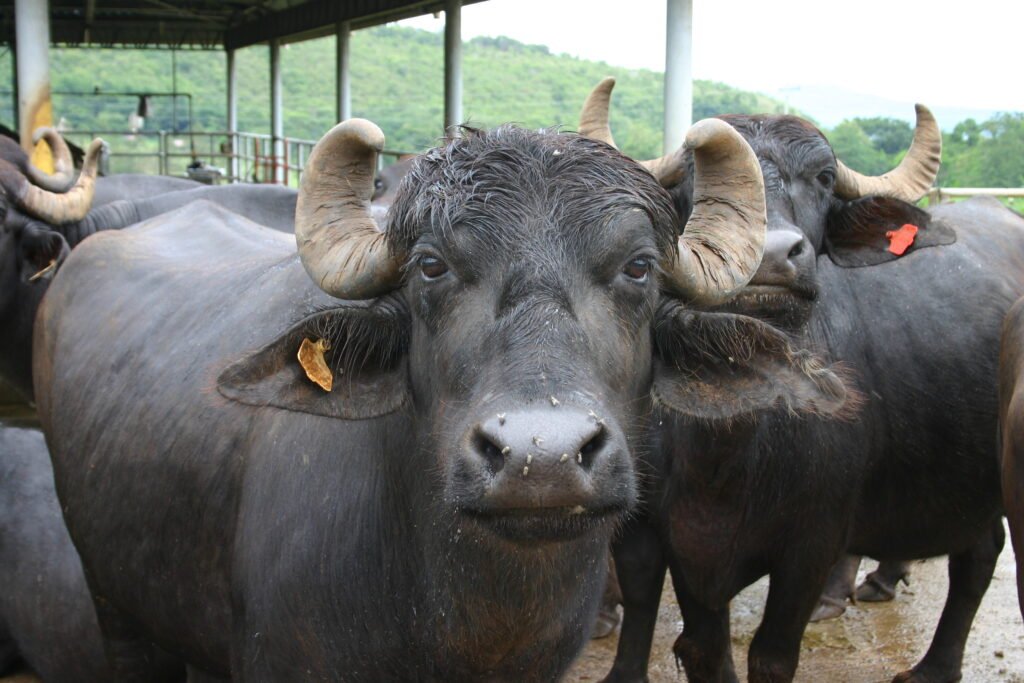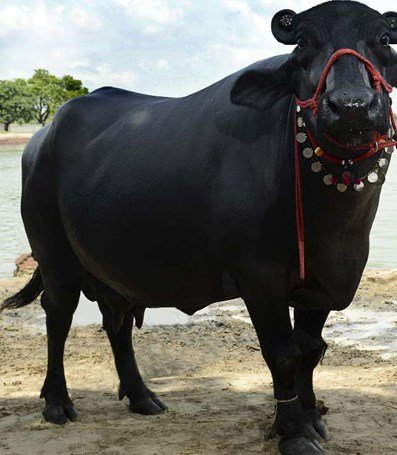Milk Production with Murrah Buffaloes
Welcome to my blog, Krushimantri, where I will share my personal experience and insights on dairy farming, specifically about the Murrah Buffaloes breed. These domestic water buffaloes are commonly found in the Indian subcontinent and are known for their high milk yield, making them a popular choice for dairy farmers.
The Murrah Buffaloes’ appearance is distinct with their black skin and short, tightly curled horns. They have a massive body size, with mature males weighing up to 1,200 kg and females up to 800 kg. These buffaloes are docile and can adapt to different climatic conditions, making them suitable for farming in various regions.
Aside from their high milk yield, Murrah Buffaloes’ dung is also highly valued as fuel and fertilizer. This breed plays a significant role in the economy of many countries in the Indian subcontinent where dairy farming is a crucial source of income for rural households.

Advantages of Murrah Buffaloes
Murrah Buffaloes offer several advantages over other breeds, making them a popular choice for dairy farming. Here are some of the key advantages of Murrah Buffaloes:
- High Milk Yield: Murrah Buffaloes are known for their high milk yield, producing up to 20-25 liters of milk per day on average. This makes them a profitable choice for dairy farmers.
- High Fat and Protein Content: The milk produced by Murrah Buffaloes has a higher fat and protein content than cow’s milk, making it a better option for producing dairy products such as butter, cheese, and yogurt.
- Adaptability: Murrah Buffaloes are adaptable to different climatic conditions, making them suitable for farming in a variety of regions. They can withstand heat, cold, and humidity, making them a hardy breed.
- Docile Nature: Murrah Buffaloes are generally docile and easy to handle, making them ideal for small-scale farming operations.
- Multiple Uses: Apart from milk, Murrah Buffaloes also provide dung, which is used as fuel and fertilizer. This makes them a valuable asset for rural households.
- Low Feed Cost: Murrah Buffaloes can thrive on a variety of feeds, including low-quality roughage, making them a cost-effective choice for farmers.
Murrah Buffaloes offer high milk yield, high-fat and protein content, adaptability, docile nature, multiple uses, and low feed cost, making them an excellent choice for dairy farming.
Disadvantages of Murrah Buffaloes
Murrah buffaloes, like any other breed of livestock, have their own set of disadvantages. Here are some of the disadvantages of Murrah buffaloes:
- High initial investment: Murrah buffaloes are known for their high milk production capacity and are therefore expensive to purchase. The initial investment for buying a Murrah buffalo can be quite high, making it difficult for small-scale farmers to afford them.
- High maintenance cost: Murrah buffaloes require a lot of care and attention. They need to be fed a balanced diet and housed in comfortable and hygienic conditions. The cost of maintaining them can be quite high, especially for farmers who do not have access to good grazing land.
- Health issues: Murrah buffaloes are prone to a variety of health issues, including mastitis, foot and mouth disease, and tick infestations. These health issues can lead to a decrease in milk production and can also be expensive to treat.
- Low adaptability: Murrah buffaloes are native to the Indian subcontinent and are not well adapted to other climates. They can have difficulty adapting to different environmental conditions, making it difficult for them to thrive in areas outside of their native range.
- Limited market: The market for Murrah buffalo milk and products is limited to certain regions where they are popular. Farmers who breed Murrah buffaloes may have difficulty finding buyers for their milk and products if they are not located in these regions.
It’s important to note that these disadvantages do not apply to all farmers or all Murrah buffaloes. With proper care and management, Murrah buffaloes can be a valuable asset to any dairy farming operation.
Physical Character sticks of Murrah Buffaloes
- Body size and shape: Murrah buffaloes are large and heavy animals, with a typical body weight of 500-600 kg for females and 800-1000 kg for males. They have a stocky, muscular build and a broad, deep chest.
- Coat color and texture: Murrah buffaloes have a shiny black coat that is short and thick. Their skin is loose and pliable, allowing them to regulate their body temperature in hot climates.
- Head and horns: Murrah buffaloes have a large, broad head with a prominent forehead and a short, broad muzzle. They have small, upward-curving horns that are usually black or dark brown in color.
- Eyes and ears: Murrah buffaloes have large, expressive eyes that are usually brown in color. Their ears are relatively small and rounded.
- Udder and teats: Murrah buffaloes have a large udder with four teats, two in front and two in the rear. The udder is well developed and has a capacity for high milk production.
- Legs and hooves: Murrah buffaloes have strong, sturdy legs with large, cloven hooves. Their hooves are adapted for walking on rough terrain and provide good traction on slippery surfaces.
Overall, Murrah buffaloes are well adapted to hot and humid climates and have physical characteristics that make them well-suited for dairy farming.

READ:- Fish farming in Maharashtra
Murrah Buffalo Price
Dairy farming has been a profitable business in India for decades. Among the different breeds of buffalo used for dairy farming, the Murrah buffalo is a popular choice due to its high milk production capacity. However, the price of a Murrah buffalo can vary depending on several factors, making it important to understand the requirements and care needed for successful Murrah buffalo dairy farming.
The price of a Murrah buffalo in India can range from INR 50,000 to INR 200,000 or more, depending on factors such as age, gender, weight, milk production capacity, and market demand. Generally, high-yielding Murrah buffaloes with a proven track record of milk production can fetch even higher prices.
To ensure successful Murrah buffalo dairy farming, proper care and management are crucial. The buffaloes should be provided with a clean and spacious living space, good quality feed, and proper veterinary care. The feed should include a balanced diet of green fodder, dry fodder, and concentrate feed to meet the nutritional needs of the buffalo.
The Murrah buffalo also requires a regular schedule of milking and breeding to maintain its milk production capacity. Proper hygiene practices should be followed during milking to prevent the spread of infections. The buffalo should also be bred with a high-yielding bull to produce offspring with good milk production capacity.
In addition to these requirements, it is also important to keep up with the latest developments and advancements in Murrah buffalo dairy farming. By staying informed and implementing best practices, dairy farmers can maximize the potential of their Murrah buffalo herd and ensure long-term profitability.
Murrah buffalo dairy farming can be a profitable business with the right care and management. While the price of a Murrah buffalo may vary, their high milk production capacity makes them a valuable asset to any dairy farm. By following proper care and management practices, dairy farmers can ensure the health and productivity of their Murrah buffalo herd, leading to long-term success in the dairy industry.
Requirements and Care for Murrah Buffalo Dairy Farming
- Shelter: Provide a well-ventilated shelter for the Murrah buffaloes to protect them from extreme weather conditions, such as heat, cold, and rain. The shelter should be spacious enough for the animals to move around freely, with adequate drainage and lighting.
- Feeding: Provide a balanced diet of green and dry fodder, along with concentrate feed and mineral mixture. Feed the Murrah buffaloes at regular intervals, and ensure that they have access to clean water at all times.
- Milking: Milk the Murrah buffaloes twice a day, preferably at the same time each day. Use proper milking equipment and techniques to ensure hygiene and reduce the risk of mastitis.
- Health care: Schedule regular check-ups with a veterinarian, and ensure that the Murrah buffaloes receive timely vaccinations and deworming treatments. Monitor their health closely and address any health issues promptly.
- Breeding: Ensure that the Murrah buffaloes are bred at the right age and with healthy breeding stock. Keep detailed records of their breeding history and monitor their reproductive health.
- Cleanliness: Maintain a clean and hygienic environment for the Murrah buffaloes, with regular cleaning of their shelter and milking equipment. Proper waste management and sanitation practices can help prevent the spread of diseases.
- Training and management: Hire trained and experienced staff to manage the Murrah buffalo dairy farm, and provide them with proper training and supervision. Ensure that the staff follows standard operating procedures for feeding, milking, health care, and other aspects of dairy farming.
By following these requirements and care tips, you can help ensure the health and productivity of your Murrah buffaloes, and maintain a profitable and sustainable dairy farm.
Murrah Buffalo Feed Schedule Chart
| Time of Day | Feed Type | Quantity |
|---|---|---|
| Morning | Green Fodder (e.g. Napier Grass, Maize, or Sorghum) | 25-30 kg |
| Dry Fodder (e.g. Wheat Straw, Paddy Straw, or Corn Stalks) | 2-3 kg | |
| Concentrate Feed (e.g. Soybean Meal, Groundnut Cake, or Corn) | 1-2 kg | |
| Mineral Mixture | As required | |
| Afternoon | Green Fodder | 25-30 kg |
| Dry Fodder | 2-3 kg | |
| Concentrate Feed | 1-2 kg | |
| Mineral Mixture | As required | |
| Evening | Green Fodder | 25-30 kg |
| Dry Fodder | 2-3 kg | |
| Concentrate Feed | 1-2 kg | |
| Mineral Mixture | As required |
It’s important to note that this is a general guideline and the actual feed requirements for a Murrah buffalo may vary depending on factors such as the animal’s weight, age, and milk production level. The quality and availability of feed may also affect the feeding schedule. It’s always best to consult with a veterinarian or a qualified animal nutritionist to determine the best feeding plan for your Murrah buffaloes based on their specific needs and circumstances.
Fodder Production
Fodder production is an important aspect of Murrah buffalo dairy farming, as it provides the animals with the necessary nutrition for milk production and overall health. Here are some tips for producing fodder for Murrah buffaloes:
- Identify suitable fodder crops: Choose suitable fodder crops that are adapted to the local climate and soil conditions. Common fodder crops for Murrah buffaloes include Napier grass, Maize, Sorghum, Lucerne, and Cowpea.
- Plan for the cropping cycle: Plan the cropping cycle based on the availability of water and other resources. Depending on the crop, it may take 60 to 120 days for the fodder to be ready for harvesting.
- Optimize land use: Optimize land use by using intercropping, crop rotation, and mixed cropping. This can help increase the yield and quality of fodder and reduce the risk of disease and pest infestations.
- Use proper cultivation techniques: Use proper cultivation techniques such as land preparation, sowing, fertilization, and irrigation. Proper weed control and pest management can also help optimize fodder production.
- Harvest at the right time: Harvest the fodder at the right time to ensure optimal nutrient content and palatability. Depending on the crop, it may be harvested at different stages, such as the vegetative stage, pre-flowering stage, or maturity stage.
- Store properly: Store the fodder properly to maintain its nutrient content and prevent spoilage. The harvested fodder can be stored as hay, silage, or dried fodder, depending on the available resources and climate.
- Monitor and adjust: Monitor the fodder production and adjust the cropping cycle and cultivation techniques as needed to optimize yield and quality.
By following these tips for fodder production, you can ensure a consistent and reliable source of nutrition for your Murrah buffaloes, leading to optimal milk production and overall health.
READ:- Profitable Goat Farming
We hope this blog is vital for you; hence more information regarding any agriculture sector, stay tuned with Krushimantri.com
And more information regarding any travel, stay turned with urbanchats.com









